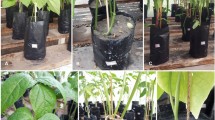Abstract
A representative survey was made of maize ears of the 1988 and 1989 crop in Austria to establish the influence of corn borer injuries onFusarium species involved in ear fusariosis andFusarium toxin production.
TheFusarium species most frequently isolated from rot-damaged ears wereFsacchari var. subglutinans (about 50 %) andF. graminearum (about 30 %). There was a striking difference between theFusarium species of the Liseola and the Discolor section concerning their occurrence on corn borer-damaged ears. More than 80 % of the ears infected withF. sacchari var. subglutinans andF. verticillioides, but less than 15 % of the ears infected withF. graminearum, F. crookwellense andF. culmorum showed corn borer injuries.
Toxin analyses of the infected ears corresponded to the known toxigenicity of the respectiveFusarium species. Ears infected withF. sacchari var. subglutinans contained moniliformin (up to 20 mg/kg), those infected withF. verticillioides fumonisin B1 and B2 (up to 15 mg/kg). In ears infected withF. graminearum, F. culmorum andF. crookwellense zearalenone (up to 40 mg/kg) and deoxynivalenol (up to 500 mg/kg) or nivalenol (up to 10 mg/kg), respectively, could be detected. Hence measures to combat the European corn borer will mainly reduce moniliformin and fumonisin contamination, but will affect zearalenone, deoxynivalenol and nivalenol contents of the ears to a much lesser extent.
Similar content being viewed by others
References
Lew H, Müllner E, Hager R, Gregor M (1979) Fütterungsprobleme bei Mastschweinen verursacht durch fusarientoxinhältigen Mais. Die Bodenkultur 30: 309–316
Schuh M, Glawischnig E, Leibetseder J (1982) Natural occurrence of mycotoxicoses in Austria associated with mycotoxin-contaminated feedstuffs. Proceedings of the V. International IUPAC Symposium on Mycotoxins and Phycotoxins, Vienna
Koehler B (1959) Corn ear rots in Illinois. Illinois Agricultural Experiment Station Bulletin 639
Compendium of corn diseases (1980) Shurtleff MC ed. Published by the American Phytopathological Society
Bottalico A, Logrieco A, Visconti A (1989)Fusarium species and their mycotoxins in infected corn in Italy. Mycopathologia 107: 85–92
Adler A, Lew H, Edinger W (1990) Vorkommen und Toxigenität von Fusarien auf Getreide und Mais in Österreich. Die Bodenkultur 41: 145–152
Nirenberg H (1976) Untersuchungen über die morphologische und biologische Differenzierung in der Fusarium Sektion Liseola. Mitt. Biol. Bundesanst. Land-Forstwirtsch. Berlin-Dahlem 169: 1–117
Gerlach W, Nirenberg H (1982) The genusFusarium — a pictorial atlas. Mitt. Biol. Bundesanst. Land-Forstwirtsch. Berlin-Dahlem 209: 1–406
Nelson PE, Tousson TA, Marasas WFO (1983)Fusarium species. An illustrated manual for identification. Pennsylvania State University Press
Gelderblom WCA, Jaskiewicz K, Marasas WFO, Thiel PG, Horak RM, Vleggaar R, Kriek NPJ (1988). Fumonisins — novel mycotoxins with cancer-promoting activity produced byFusarium moniliforme. Appl. Environ. Microbiol. 54: 1806–1811
Sydenham EW, Gelderblom WCA, Thiel PG, Marasas WFO (1990) Evidence for the natural occurrence of fumonisin B1, a mycotoxin produced byFusarium moniliforme, in corn. J. Agric. Food. Chem. 38:285–290
Author information
Authors and Affiliations
Rights and permissions
About this article
Cite this article
Lew, H., Adler, A. & Edinger, W. Moniliformin and the European Corn Borer (Ostrinia nubilalis). Mycotox Res 7 (Suppl 1), 71–76 (1991). https://doi.org/10.1007/BF03192189
Issue Date:
DOI: https://doi.org/10.1007/BF03192189




